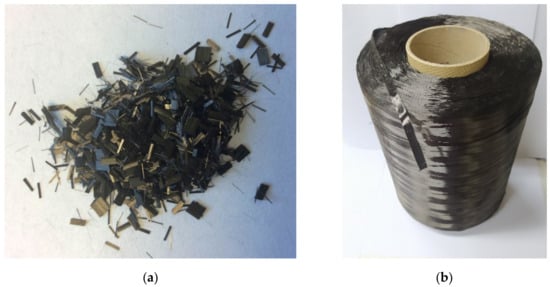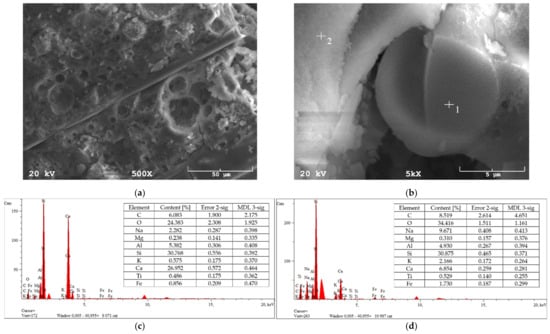Carbon fibers (CFs) can be applied in different forms of occurrence in the geopolymer matrix. The most popular seem to be short CFs because they are easy to use for different applications. Most manufacturing methods do not require significant changes to implement the short fibers, despite the application of long fibers or textiles. However, several research works involved short fibers; a significant part of them concerns work made with the addition of long fiber fabrics as composite elements, carbon fiber felt, or similar forms, as well as the addition of other forms of carbon, i.e., graphene, graphite, or waste CF used in the manufacture of aviation products. The last three additives were introduced most frequently into geopolymers in the form of particles.
1. Short and Long Carbon Fibers
Theoretically, the difference between short and long CFs can be determined by a mathematical calculation based on fiber tensile strength, fiber diameter, and interfacial shear strength. According to this model, the proper length of the fiber will improve flexural strength and fracture properties. It implies significant strengthening and toughening effects [
38]. In practice, many authors prefer the experimental approach due to some problems with finding appropriate input data for the theoretical model, especially due to the changeable properties of the matrix used, which are typical for cementitious materials [
15,
38].
The typical fibers used have a form of chopped short fibers with a length of 3 to 60 mm and a diameter from a few μm or long fibers, such as roving applied throughout the entire length of the samples or the investigated element (
Figure 1) [
15,
39,
40].
Figure 1. Different forms of carbon fibers. (
a) Short carbon fibers [
39] and (
b) long carbon fibers (roving) [
40].
The amount of short CF in geopolymer composites is usually 1–2 wt.% of the geopolymer mass, or even less, up to 1.0 vol.% [
6,
15,
39]. This amount effectively increases the mechanical properties of the composite, as well as its ductility [
6,
15]. The addition of a larger amount of CF usually causes problems with the processing properties of the composites, especially in the case of short fibers [
39]. In the case of long fibers, it is possible to increase the used amount of fibers; however, the investigations show that the optimal amount is between 0.1–2.0 wt.% and depends on the type of geopolymer matrix used [
6,
15,
40].
The CF usually has good coherence with different types of geopolymer matrices. The microscope investigation shows a lack of decohesion between the CF and the geopolymer matrix (
Figure 2a,b). Additionally, energy-dispersive X-ray spectroscopy (EDS) analysis confirms coherence between the CF and matrix material (
Figure 2c,d). The EDS analysis carried out at point 1 concerning the fiber material covered with the geopolymer and the analysis carried out at point 2 concerning the geopolymer matrix material (
Figure 2b) shows similar results that are probably the effect of covering the CF by a thin layer of matrix material [
14].
Figure 2. Scanning microscopy of short fibers in the geopolymer matrix. (
a) Description of what is contained in the first panel; (
b) description of what is contained in the second panel; (
c) EDS analysis for point 1; (
d) EDS analysis for point 2 [
14].
It is also worth noticing that it is possible to improve the adhesion of CFs to the geopolymer matrix by using plasma pretreatment of the fibers, which may both change their surface topography, making their surface rougher, and depositing new functional groups on their surface, allowing them to bond with the matrix more effectively [
41,
42]. The mechanism of surface modification depends on the gas used in the plasma generator. For example, argon plasma makes the surface rougher due to plasma etching and improves the interlaminar strength by increasing the adhesion of fibers to the geopolymer matrix [
41,
43].
Recently, some trials were made with sizing methods, which create the physical-chemical link between a surface of CF and a geopolymer matrix [
44]. They show that the sizing of a CF has a strong influence on the impregnation of a CF by minerals, as well as affecting the quality of the bonding between a CF and a geopolymer matrix [
44]. It is worth noticing that this method was not investigated and it seems to be a perspective for further investigation.
2. Textiles, Grids, and Fabrics
Textiles, grids, and fabrics reinforced in a geopolymer matrix are very often applied in the context of improving mechanical properties, including material behavior in elevated temperatures [
45,
46]. This kind of reinforcement is applied as one or multiple layers of 2D or 3D fabrics or grids [
46,
47]. These kinds of composites have many advantages; however, they also have some weak points, including high cost and partial carbon oxidation at high temperatures [
48,
49]. In the case of the design of this type of geopolymer, the main challenge is usually the proper bond between the textile reinforcement and the geopolymer matrix [
46,
49]. The bonding is usually the weakest element of the composite where the failure mechanism started [
46,
49].
The reinforcement of carbon textiles compared to other types of textiles generally shows better mechanical properties, especially tensile strength and Young’s modulus [
31,
50]. Additionally, these kinds of composites are investigated as materials against electromagnetic fields that are emitted by electronic and telecommunication devices, such as mobile phones [
51]. The research in this area was carried out using the reinforcement of geopolymer composites with carbon or basalt fiber grids and nanoparticles of MgO [
52]. The results show the shielding efficiency of the investigated solution with the CF in the 30 MHz–1.5 GHz frequency range [
51]
3. Carbon Microfibers, Nanofibers, and Carbon Nanotubes
In recent years, micro and nanofibers became more and more popular as an additive to the geopolymer matrix. It is not only the result of their excellent mechanical properties, but also new research, including the development of new methods of biodegradation of these nanomaterials by fungi, bacteria, plants, animals, and microbial enzymes, which make it more environmentally friendly [
52]. The micro and nanofibers could have different threads, filaments, whiskers, nanotubes, nanoparticles, and also other graphene-based materials with diameters of about 0.5–1.5 μm or even finer [
53,
54]. The implementation of this type of reinforcement comparison with traditional CFs helps in the homogenous distribution of the fibers [
53,
54]. In the case of nanoreinforcement, the most obvious advantages appear to be small amounts of material, usually less than 0.2 wt.%, especially from the point of view of increasing mechanical properties [
53,
55,
56]. As part of geopolymer composites, in addition to improving their mechanical properties [
56], carbon nanotubes can lower their porosity and decrease the water absorption rate to improve their durability in humid or aggressive environments [
56,
57]. It also positively influences crack reduction and prevents any catastrophic fractures, including thermal cracks at elevated temperatures [
47,
57,
58]. They also significantly increase electrical conductivity [
59].
Other studies on the addition of microfibers (fibers about 100 μm in length) were carried out in the weight ratio of 0, 5, 10, and 15% to the metakaolin-based geopolymer matrix [
58]. The mechanical properties were tested after 28 days at temperatures of 30 °C, 200 °C, 400 °C, and 800 °C. The best results were obtained for the 10% addition of the carbon microfiber, for temperatures of 30 °C and 200 °C. They were for 30 °C—44.2 MPa for the material with a 10% addition of microfibers and 28.4 MPa for the matrix material. By analogy, the compressive strength for a temperature of 200 °C was 48.8 MPa and 36.6 MPa, respectively. The best values were achieved for temperatures of 400 °C and 800 °C for a 15% fiber addition. They were, respectively, 33.5 MPa and 24 MPa, compared to 14.8 MPa and 11.2 MPa for a pure matrix for the same temperatures [
58]. Research was also carried out on the addition of carbon nanotubes to geopolymers, both as an additive to metakaolin-based matrices [
60,
61] and fly ash [
56]. The addition of nanotubes enhanced the mechanical properties of the composites.
Other research shows that geopolymer composites with silica-grafted carbon nanotubes can be protective materials against electromagnetic radiation [
62,
63]. Obtaining effective shielding properties requires the use of a large number of carbon nanotubes—the highest effectiveness was achieved with a 5 vol.% addition of nanomaterial [
63].
4. Hybrid Reinforcement
Carbon fibers are also used for hybrid reinforcements, i.e., with two different types of fibers. The correct combination of different types of fiber could efficiently improve composite properties [
64,
65]. In this kind of composition, a synergistic effect occurs by strengthening the influence of one fiber on the matrix on the other one. In the results obtained, the properties of the composite are better than the sum of the application of both fibers separately [
65,
66].
Yang et al. [
64] investigated carbon nanotubes (30–50 nm in diameter) combined with polyamide (PA) fibers, with a length of 5 mm and a diameter of 12 µm. The metakaolin-based geopolymer was activated with phosphoric acid. The fibers were added to the matrix in the following proportions: 0.0, 0.5, 1.0, 1.5, 2.0, and 2.5 wt.% [
64]. The behavior of the material without reinforcement was compared with that of PA fiber reinforcement and hybrid reinforcement. The greatest mechanical properties were reached for the hybrid reinforcement. The compressive strength was about 115 MPa for 1.5% of the hybrid reinforcement comparison to the same amount of PA fibers (approximately 90 MPa), which significantly increased. This improvement was even more significant compared to the value obtained for a pure matrix—51.7 MPa [
64]. Research also confirmed an increase in bending strength and fracture properties. The composite with a 1.5% addition of hybrid fibers has about 38 MPa of bending strength compared to 27 MPa for the same amount of PA and 9.9 MPa for the reference sample (without reinforcement) [
64].
Promising results were also obtained for hybrid steel and carbon reinforcement [
65]. Both fibers are also well-known as reinforcements that develop the mechanical properties of the geopolymer matrix [
66,
67,
68]. The research involves a lightweight geopolymer matrix based on fly ash and microspheres. The results of this investigation show an improvement in the mechanical properties of composites. The highest value of bending strength was obtained for reinforced 1.5 wt.% CFs and 0.5 wt.% steel fibers [
67]. Similar works were made for hybrid reinforcement with carbon and SiC fibers. They show an improvement in flexural strength and also Young’s modulus for compositions at elevated temperatures [
69,
70,
71].
This entry is adapted from the peer-reviewed paper 10.3390/fib11020017


